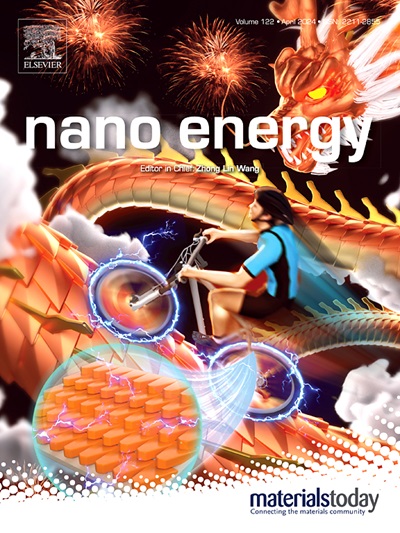硅异质结上胶体量子点的热释光效应用于高探测率红外光探测器
IF 16.8
1区 材料科学
Q1 CHEMISTRY, PHYSICAL
引用次数: 0
摘要
溶液加工的胶体量子点(CQDs)在红外光探测领域引起了极大的兴趣,特别是由于它们易于与硅基电子器件集成。其中,硫化银(Ag2S)CQDs 作为无毒红外半导体脱颖而出。然而,与基于硫化铅和碲化汞 CQDs 的器件相比,它们在光电探测器中的应用历来显示出较低的探测率。在这里,我们展示了 Ag2S CQD/硅 p-n 异质结光电探测器的报告,该探测器的探测能力大大提高。Ag2S CQDs 中的热释光效应(PPE)显著增加了光电流,从而促进了探测能力的提高。因此,CQD/硅光电探测器的检测率提高了 17 倍,在 980 纳米波长处达到 4.1×1010 琼斯。这些发现为将 CQDs 用于热释光驱动的溶液加工光电器件提供了新的机遇。本文章由计算机程序翻译,如有差异,请以英文原文为准。

Pyro-phototronic effect in colloidal quantum dots on silicon heterojunction for high-detectivity infrared photodetectors
Solution-processed colloidal quantum dots (CQDs) have attracted significant interest for infrared photodetection, particularly due to their easy integration with silicon-based electronics. Among these, silver sulfide (Ag2S) CQDs stand out as non-toxic infrared semiconductors. However, their application in photodetectors has traditionally shown lower detectivity compared to devices based on lead sulfide and mercury telluride CQDs. Here we demonstrate report Ag2S CQD/silicon p-n heterojunction photodetectors that exhibit substantially enhanced detectivity. This improvement was facilitated by the pyro-phototronic effect (PPE) in Ag2S CQDs, which significantly increases the photocurrent. Consequently, the detectivity of the CQD/silicon photodetector was improved by a factor of 17, reaching 4.1×1010 Jones at 980 nm. These findings pave the way for new opportunities in utilizing CQDs for pyro-phototronic driven, solution-processed optoelectronic devices.
求助全文
通过发布文献求助,成功后即可免费获取论文全文。
去求助
来源期刊

Nano Energy
CHEMISTRY, PHYSICAL-NANOSCIENCE & NANOTECHNOLOGY
CiteScore
30.30
自引率
7.40%
发文量
1207
审稿时长
23 days
期刊介绍:
Nano Energy is a multidisciplinary, rapid-publication forum of original peer-reviewed contributions on the science and engineering of nanomaterials and nanodevices used in all forms of energy harvesting, conversion, storage, utilization and policy. Through its mixture of articles, reviews, communications, research news, and information on key developments, Nano Energy provides a comprehensive coverage of this exciting and dynamic field which joins nanoscience and nanotechnology with energy science. The journal is relevant to all those who are interested in nanomaterials solutions to the energy problem.
Nano Energy publishes original experimental and theoretical research on all aspects of energy-related research which utilizes nanomaterials and nanotechnology. Manuscripts of four types are considered: review articles which inform readers of the latest research and advances in energy science; rapid communications which feature exciting research breakthroughs in the field; full-length articles which report comprehensive research developments; and news and opinions which comment on topical issues or express views on the developments in related fields.
 求助内容:
求助内容: 应助结果提醒方式:
应助结果提醒方式:


